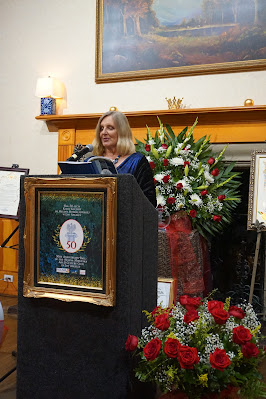Helena Modjeska Art and Culture Club is pleased to invite
you to a lecture on Saturday, January 15, 2022 at 12 noon in California. Please
send requests for a Zoom link and detailed information to prezes@modjeska.org.
Janusz Bieszk: The Kingdom of Lehia and the Kingdom of the
Weneds in the ancient and medieval periods
Lecture by zoom January 15, 2022, noon in California, Gdynia - Los Angeles. The entire presentation will be in Polish.
I. Author's biography:
Janusz Bieszk, born in 1948 is a history enthusiast and researcher, and a bibliophile. He holds a master’s degree in the field of foreign trade and foreign service. For many years, he worked in managerial positions in Poland and abroad. With a passion for forgotten history he pursued his interests for decates and included the results of his independent historical research in a series of popular books describing the following historical periods:
1. Prehistory - Space Civilizations on Earth,
2. Antiquities - Slavic Kings of Lehia in Ancient Poland,
The Kings of Lehia
and Lehites in History,
Ancient Kingdom of
Lehia
More Evidence, Forgotten
Ancient Kingdom of Lehia II
Evidence and
Historical Atlas of Lehia, Sarmatia, Scythia,
3. The Middle Ages - Castles of the Teutonic State in Poland
and
Christian Kings of
Lehia in Medieval Poland.
Mr. Bieszk also edited the introduction and footnotes to the
new edition of Prokosz's Slavic-Sarmatian Chronicle from the 10th century,
Polish edition.
He documented his books with citations from an extensive
Polish and foreign bibliography.
To order books: https://www.swiatksiazki.pl/catalogsearch/result/?q=Bieszk+Janusz
Mr. Bieszk cordially invites you to experience together and
discuss the documented stories about our great and outstanding ancestors of the
Aria-Praslavians, the kings of Lehia, the knights of the coat of arms Leh and
the steadfast sailors of Weneds.
II. Title:
The Kingdom of Lehia and the Kingdom of the Weneds in the
ancient and medieval periods.
As the introduction to the lecture, Maja Trochimczyk will
show a photo with all published books by the author, and a 3-min YouTube video
under the title "The Lehia Empire and its Capitals through the ages. Mr. Bieszk will provide
comments to this introduction.
III. Sections of the lecture:
1. Definitions: "Slavs" in Polish are Slawianie,
not Slowianie. Lehia, Leh, Lehici with "h" not Lechia, Lech, Lechici
with “ch”
2. The meaning of the words "Leh" and
"Lehía", and also Leh = Wit or Wist.
3. Slavs or Slawianie as an agricultural, peaceful, free and
religious people
4. Religion and beliefs of the Pra-slavians
5. The oldest historical sources (yearbooks, chronicles) with information
- domestic
- foreign
6. The oldest artifacts and facts
- construction of
the Praslavians
- Praslavian
battles
- the oldest image
of a freight car
- inscription on
the tombstone from the 1st century AD
7. A short and full set of Sarmatian-Lehitic kings
8. The kings of the Weneds
9. Emperors of Lehia Empire
10. Historical Atlas of Lehia, Sarmatia and Scythia
11. Catalog of coins minted by the rulers of Lehia
The presentation will conclude with presenting Mr. Bieszk’s three
Open Appeals to the national authorities followed by participants' questions
and discussion.
LEHIA ON THE MAP
https://www.youtube.com/watch?v=gaN1B7vkFOk&t=6s
Janusz Bieszk’s interview for Nowy Dziennik Polish Weekly
(September 14, 2016). Th. 4.
- Do you think that knowledge about the ancient history
of Poland is hidden? What is the reason for this?
Everything points to the fact that we still have a
post-church history and a pro-church history, where many topics, events, facts
and even historical figures like kings are taboo.
For example knowledge of the following facts has not been described
in the historical literature and information about these facts has not been disseminated
in the society:
1. The above-mentioned tombstone with a dedication from
Emperor Tiberius Claudius, translated from Latin and published in 1843 by Polish
researcher, archaeologist and numismatist Tadeusz Wolański, who studied our
ancient history. Wolanski considered Prokosz
Chronicles of the 10th century to be true history of ancient Poland.
In 1853 the Roman-Catholic Church
declared his books forbidden and burned them at the stake. His conviction was
prevented by the intervention of Tsar Nicholas I, who also assigned a
detachment of the Russian Army to protect him during his research travels and
expeditions.
It is long overdue that a faithful copy of the ancient Roman
tombstone of a Lehia prince should be exhibited for the public at the Royal
Castle or the National Museum, as the oldest artifact concerning Kings of Lehia
dating back to the 1st century
2. Lehia and Sarmatian warriors were engaged in many battles
with the Roman legions, and plentiful evidence exists in historical sources; however, it is not disseminated.
3. The reign of the Lehite king Wrocisław in the years
892-896 is not known or publicized while it pre-dates the Piast dynasty by 70 years.
The evidence in the chronicle of Prokosz and the Aventinus annals is ignored.
4. The existence of the empire of Lehia in the years
1000-1038 is also ignored, despite the evidence contained in Polish and foreign
chronicles and annals.
5. The reign of Bolesław II the Forgotten in the years 1034-1038 is not known to today’s historians and readers. He was removed from the Roman Catholic Church and thus doomed to oblivion. His “deletion” from Polish history remains to this day, so the Church’s anathema has been quite effective. His name is not mentioned in two historical albums published in Poland in 2014 and 2015 with lists of kings.
Q: When do you think Poland was baptized?
A: According to Polish and foreign historical sources, the
baptism of the people of Lehia was not a single act that took place in 966 AD,
but a multi-stage act, involving both the Roman-Catholic and Eastern Orthodox, Slavic
(Cyril-Methodian) rites. Its chronology was as follows:
1. During the reign of King Koszyszko (842-862) on January
1, 845, fourteen Lehs - Lehite princes and magnates, with their courts, army
and people living in the south, on the border with Moravia and Bohemia were
solemnly baptized in the Roman Catholic rite. Baptism was performed by priests
with Archbishop Adalram from Olomouc in Great Moravia, who was subordinate to
the Archbishopric in Passau, Bavaria. The above act had a practical and
tactical goal, namely to avoid the future military invasions of
Christianization by the aggressive East Frankish state.
2. In the middle of the 9th century, especially during the
reign of King Ziemowit the Reformer (862-892) and with his consent, the
Christian religion in the Eastern Orthodox, Slavic rite began to penetrate the
population of Lesser Poland. It was taught by the priests of Wisnog and Oslaw,
students of Archbishop Methodius, who was in Velehrad in Great Moravia. The
bishop of Lehites at that time was Sawa, a student of Cyril. Religion in the
Slavic rite later spread to Lesser Poland, Silesia and Greater Poland, covering
a large area of Lehia. Many Orthodox churches were built in such localities
as Wiślica, Kraków, Przemyśl, Wrocław, Poznań, Ostrów Lednicki (Lechicki) and
Gniezno.
This was confirmed by archaeological excavations. The
archbishopric of the Slavic rite in Krakow functioned for over 150 years.
3. Some kings of Lehia and their courts and attendants were
baptized in the Eastern Orthodox, Slavic rite and ruled together for over 100
years as Christians. In my opinion, they were:
Ziemowit Reformator, who ruled in the years 862-892;
Wrocisław who ruled in 892-896;
Leh X Brave in 896-921;
Ziemomysl in 921-957;
Mieczysław II in 957-999.
The first king called Mieczysław ruled in 340-388. According
to Polish chronicles and annals, Mieczysław II died in 999. Mieczysław II was elected
as king of Lehia at a valid rally in 957, retained the title of king in
accordance with the custom (now the so-called protocol) until his death in 999,
regardless of the later repercussions related to the transition with his
surroundings from the Slavic rite to the Roman rite.
It probably happened in or after 968, because in the
so-called in the epitaph of Brave it is written that Bolesław was born in 967,
of a "pagan father". This is because the Roman clergy did not
recognize the Slavic rite and treated it as paganism. Mieczysław II was
baptized by the aggressive German Church, not the Czech one, as there was no
archbishopric in Prague at that time.
The official date of baptism of a part of the population of
Polania (Poland) should also be backdated to the year 845, but then the public
would have to be informed that the use of the later date was purposeful and was
designed to hide the existence Lehs - because that is what they are called in
foreign sources.






















































































































































